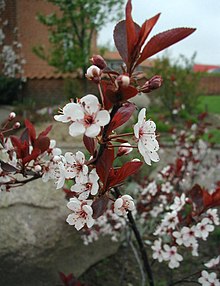Prunus × cistena
| Prunus × cistena | |
|---|---|

| |
| Flowers and foliage | |
| Scientific classification | |
| Kingdom: | Plantae |
| Clade: | Tracheophytes |
| Clade: | Angiosperms |
| Clade: | Eudicots |
| Clade: | Rosids |
| Order: | Rosales |
| Family: | Rosaceae |
| Genus: | Prunus |
| Subgenus: | Prunus subg. Prunus |
| Section: | Prunus sect. Prunocerasus |
| Species: | P. × cistena
|
| Binomial name | |
| Prunus × cistena (N.E.Hansen) Koehne
| |
Prunus × cistena, the purple leaf sand cherry or dwarf red-leaf plum, is a hybrid species of prune-cherry, the result of a cross between Prunus cerasifera (cherry plum or myrobalan plum) and Prunus pumila (sand cherry).[1] A leggy bush or shrubby tree, it typically reaches a height of 1.5–2.5 meters and has a useful life of 10–20 years. The fruit are edible, if strong-tasting. Some people make jams or preserves from them. It is not advisable to eat the pits.
Frost-tolerant, purple leaf sand cherries can be grown up to USDA Hardiness Zone 2a. Commercial specimens are typically grafted to a rootstock from any of a number of other species, which will influence their growth form and final height. There are also a limited selection of cultivars available.
Prunus × cistena was developed by Niels Ebbesen Hansen in 1910.[2] In 1993 it won the Royal Horticultural Society's Award of Garden Merit.[3]

References
- ^ Plant Facts, Prunus x cistena - Purpleleaf Sand Cherry (Rosaceae)
- ^ "Nazareth College, Purpleleaf Sand Cherry Prunus x cistena". Archived from the original on 2016-03-06. Retrieved 2018-07-15.
- ^ "Prunus × cistena". Royal Horticultural Society. 2017. Retrieved 23 February 2020.
